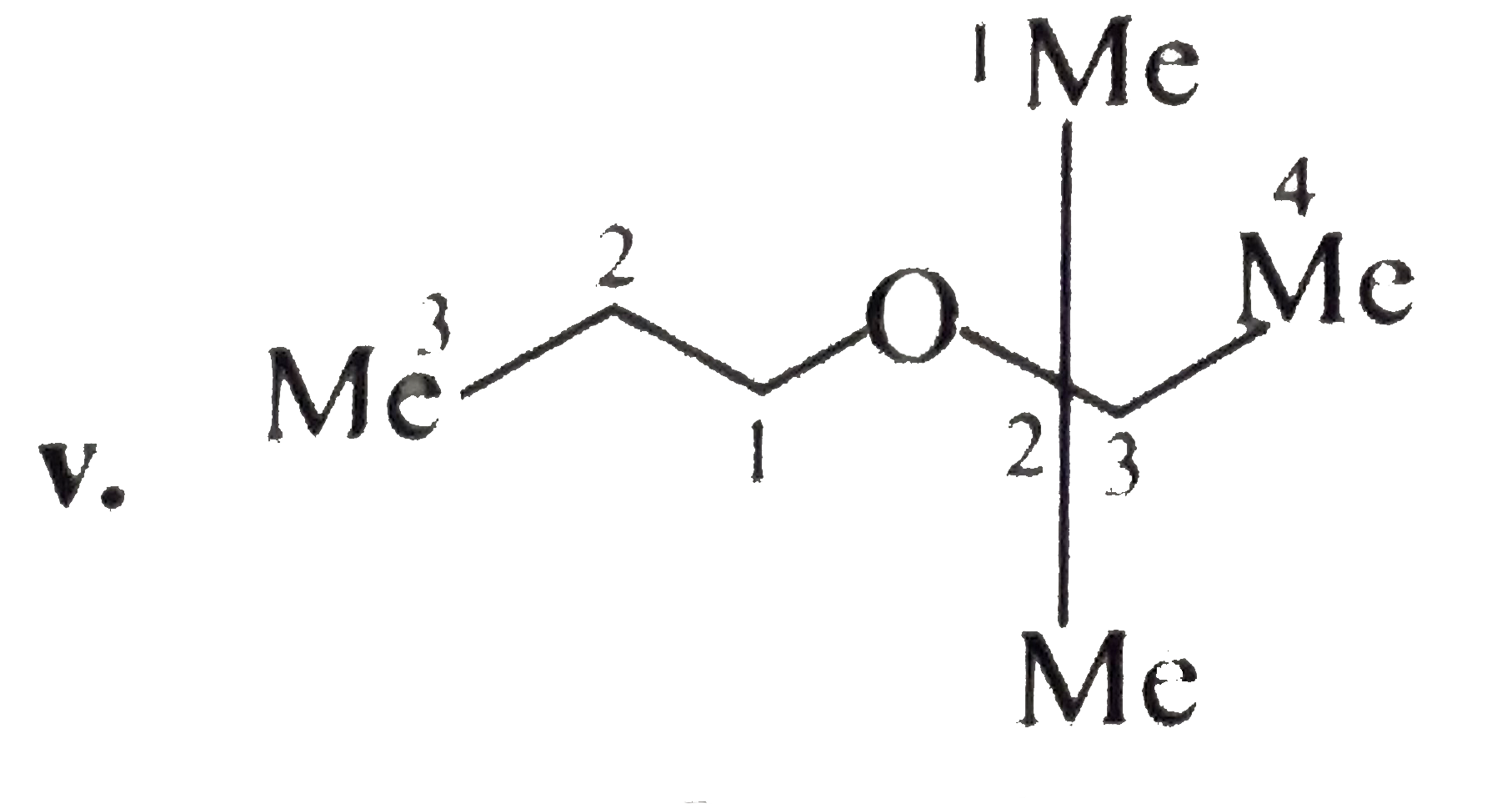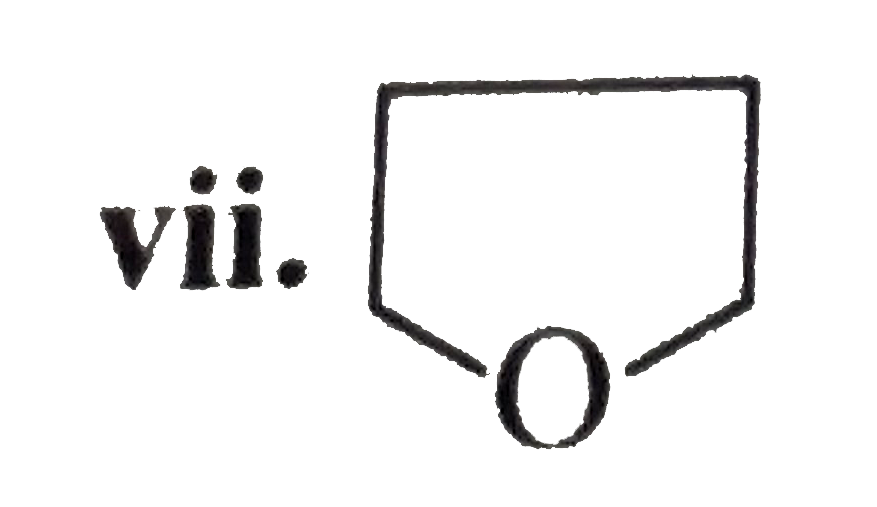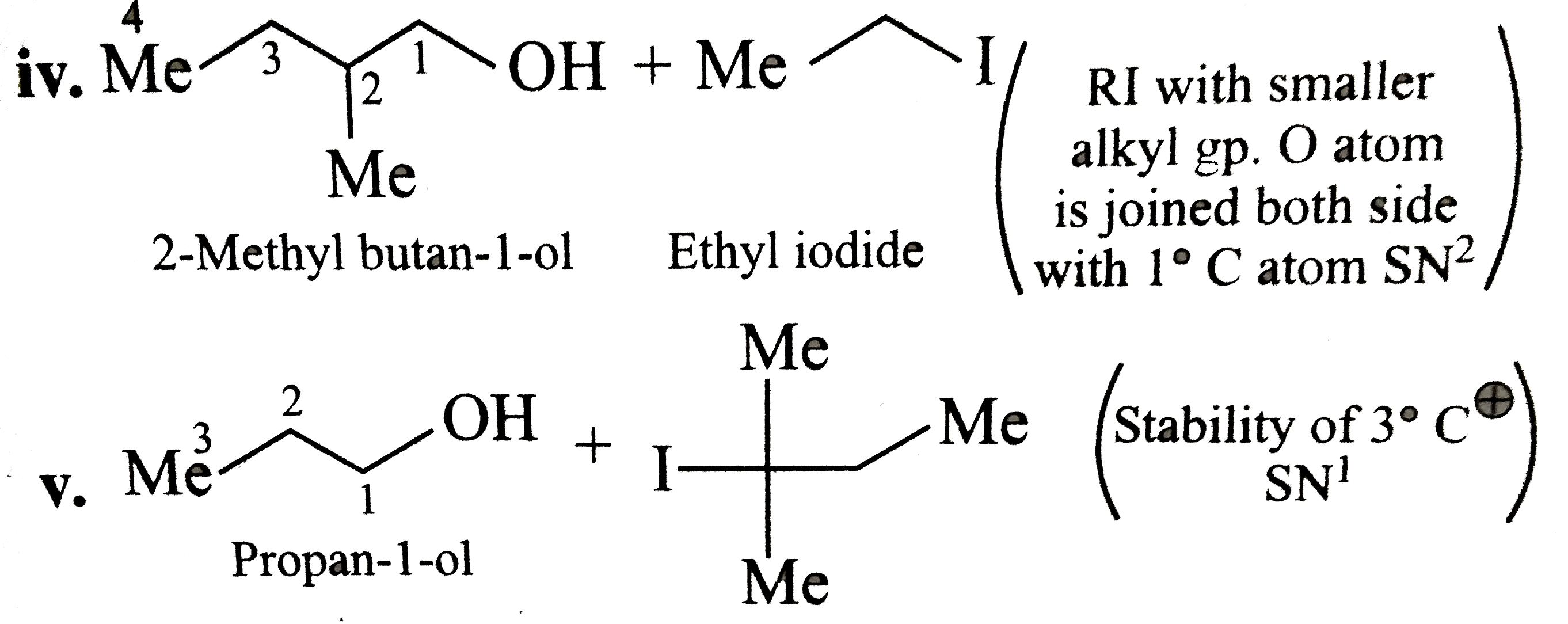a. Given the major products formed by heating the following ethers with conc. HI with metioning SN−1 or SN−2 mechanism.
i.  (1- Propoxy propane)
(1- Propoxy propane)
ii. Ph−−O−−Me (Methoxy benzene)
iii. Ph−−CH2−−O−−Et (benzyl ethyl ether)
iv.  (1-Ethoxy-2-methyl butane)
(1-Ethoxy-2-methyl butane)
v.  (2-Propoxy-2-methyl butane)
(2-Propoxy-2-methyl butane)
vi. PhCH2OPh (Benzyl phenyl ether)
vii.  (Tetrahydrofuran, THF)
(Tetrahydrofuran, THF)
b. Given the products of the above ethers with excess of HI.
c. Why does SN−2 cleavage occur at a faster rate with HI than with HCI ?
Video Solution
Text Solution
a. i. Symmetrical ether 1∘ R groups, SN−2

ii. Phenol (Ph−−OH)+MeI(SN2) (1∘ R groups)
iii. PhCH2I underset (Benzyl iodide)+overset (EtOH) underset (Ethanol)(stabilityofbenzylC^(o+))(SN^(1))<br>iv.<imga≤ocr_imageload∈g=lazysrc=https://d10lpgp6xz60nq.cloudfront.net/physics_images/KSV_CHM_ORG_P2_C12_S01_017_S02.pngwh=80%mx-autosty≤=background:white;>(RIwithsmal≤ralkylgp.Oa→misjo∈ed⊥hswith1^(@)Ca→mSN^(2))<br>v.<imga≤ocr_imageload∈g=lazysrc=https://d10lpgp6xz60nq.cloudfront.net/physics_images/KSV_CHM_ORG_P2_C12_S01_017_S03.pngwh=80%mx-autosty≤=background:white;><br>overset (PhCH_(2)I) underset (Benzyl iodide)+overset (PhOH) underset (Phenol)(StabilityofbenzylC^(o+) SN^(1))<br>vii.<imga≤ocr_imageload∈g=lazysrc=https://d10lpgp6xz60nq.cloudfront.net/physics_images/KSV_CHM_ORG_P2_C12_S01_017_S04.pngwh=80%mx-autosty≤=background:white;><br>i.<imga≤ocr_imageload∈g=lazysrc=https://d10lpgp6xz60nq.cloudfront.net/physics_images/KSV_CHM_ORG_P2_C12_S01_017_S05.pngwh=80%mx-autosty≤=background:white;>(Iodo∝a≠)<br>ii.PhOH+MeI(PhoHdoes¬undergoArSNreactionun≤ssactivatedEWG)<br>iii.PhCH_(2)I + EtI(Benzyliod+Ethyliodide)<br>iv.<imga≤ocr_imageload∈g=lazysrc=https://d10lpgp6xz60nq.cloudfront.net/physics_images/KSV_CHM_ORG_P2_C12_S01_017_S06.pngwh=80%mx-autosty≤=background:white;><br>v.<imga≤ocr_imageload∈g=lazysrc=https://d10lpgp6xz60nq.cloudfront.net/physics_images/KSV_CHM_ORG_P2_C12_S01_017_S07.pngwh=80%mx-autosty≤=background:white;><br>overset (PhCH_(2)I + PhOH) underset (Phenol doesn't undergo ArSN reactions.)<br>ThetranerofH^(o+)→ROR'isgraterwithHI,whichisastron≥racthanwithHCI.Moreover,I^((-))be∈gabeerνc≤oϕ≤thanCI^((-)), it reacts art faster rate in step 2 of the mechanism of the reaction.
|
Updated on:21/07/2023
Topper's Solved these Questions
- BOOK - CENGAGE CHEMISTRYCHAPTER - ALCOHOL,PHENOL AND ETHERSEXERCISE - Solved Examples17videos
ALCOHOL,PHENOL AND ETHERS
- BOOK - CENGAGE CHEMISTRYCHAPTER - ALCOHOL,PHENOL AND ETHERSEXERCISE - Exercises Subjective25videos
ALCOHOL,PHENOL AND ETHERS
- BOOK - CENGAGE CHEMISTRYCHAPTER - ALIPHATIC AND AROMATIC ALDEHYDES AND KETONESEXERCISE - Archives Subjective29videos
ALIPHATIC AND AROMATIC ALDEHYDES AND KETONES
Similar Questions
Knowledge Check
- Question 1 - Select One
Ethyl methyl ether is
ASolidBGasCLiquidDColloid - Question 2 - Select One
Major products formed in the reaction of t-butyl methyl ether with HI are-
A B
B C
C D
D
- Question 3 - Select One
The heating of phenyl-methyl ethers with HI produces _____________.
AIodobenzeneBPhenolCBenzeneDEthyl chlorides
Give the major products obtained on heating the ether with one equivalent of HI.
CH3−CH2−O−CH2−PhView SolutionWrite the products obtained when benzyl phenol ether is heated with HI.
View SolutionEthylene into ethyl methyl ether
View SolutionGive the major products obtained on heating the ether with one equivalent of HI.
CH3−CH2−O−CH2−CH3View SolutionThe heating of pheny1-Methyl ethers with HI produces
View Solution



